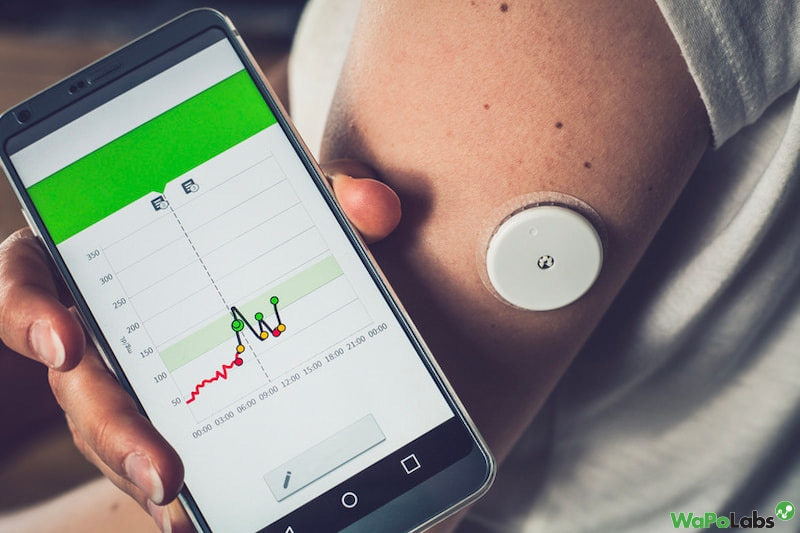An increasing number of individuals are using continuous glucose monitors (CGMs) for reasons more than solely managing their diabetes. They can help you prevent chronic diseases and possibly shed some weight. But how much does continuous glucose monitoring cost?
With CGMs, managing diabetes at home is easier and requires no finger puncturing. These devices continuously monitor and record your blood glucose levels using a tiny sensor that is inserted beneath your skin. This great benefit comes with a pretty expensive price, so how much does a continuous glucose monitoring cost you?

What Is Exactly A Continuous Glucose Monitor?
According to the CDC, nearly one in 10 Americans has diabetes, more than 37 million people in all. One in five of them don’t even aware they have the illness.
To prevent diabetes-related concerns including nerve damage, clouded vision, or hearing issues, diabetics often need to check their blood sugar levels at home.
To check if their blood sugar is within the normal range, many people prick their fingers many times each day and use test strips with a blood glucose meter (glucometer). This process could be painful and uncomfortable. But a continuous glucose monitor can prevent it (CGM).
With CGMs, managing diabetes at home is easier and requires no finger puncturing. These devices continuously monitor and record your blood glucose levels using a tiny sensor that is inserted beneath your skin.
The use of CGMs can help avoid low blood sugar by observing the changes in glucose levels. They may also lengthen the time you spend inside a regular range. Your hemoglobin A1C (HbA1C or A1C), also known as blood glucose levels, can be improved with the help of real-time feedback, which also reduces your chance of developing certain conditions including hyperglycemia and hypoglycemia.

What Are The Benefits Of Using A Continuous Glucose Monitoring?
The treatment of diabetes and lowering of disease complications depend on routine blood sugar monitoring. The benefits of home blood glucose monitoring involve
- Aids in the identification of dangerously high or low glucose levels.
- Explains the effects of diet and exercise on your blood sugar levels.
- Determines if any modifications to your treatment might be useful.
Regular monitoring of blood sugar can help you prevents
- That are complications of low blood sugar, such as
- Weakness.
- Confusion.
- Jitters.
- Sweating.
- Dizziness.
- Seizures.
- Coma.
- Those are diabetes complications, such as
- Stroke.
- Heart attack.
- Blindness.
- Kidney disease.
- Amputation.

How Much Does Continuous Glucose Monitoring Cost?
How Much Does Continuous Glucose Monitoring Cost? The annual CGM costs might vary from $1,000 to several thousand dollars. Depending on the CGM brand you use, price fluctuations. But typically, you’ll have to spend more money on
- Replaceable sensors.
- Receiver or reader.
- Transmitter.
The Dexcom G6 is a popular CGM. Both Type 1 and Type 2 diabetes can be managed using this approach. Currently, the estimated yearly retail cost is roughly $6,000, or $500 per month. Without insurance or discounts, you would have to pay that amount.
Approximately how much a Dexcom G6 system would cost is as follows:
- One-time annual cost: $437 for one receiver.
- Lasts 90 days: $300 for one transmitter.
- 30-day supply: $420 for three sensors.
There may be fewer CGM options available. The FreeStyle Libre 2 reader, for example, costs between $130 and $150 without insurance. Additionally, a month’s worth of sensors is about $130, making an annual cost of $1,560 for sensors. If you fill a 90-day supply, costs can be reduced yet further. That is what continuous glucose monitoring costs.

Do Continuous Glucose Monitors Have Health Insurance?
The majority of health insurance plans will partially or completely cover the cost of diabetes supplies and equipment. Blood glucose meters (BGMs) and CGMs are included in this.
The majority of people with commercial insurance pay $0 to $60 per month for FreeStyle Libre 2 sensors and no more than $65 per month for the suitable reader, claims Abbott, the manufacturer of the FreeStyle Libre products.
If you have original Medicare, Part B of Medicare covers the cost of certain materials and equipment used for diabetes glucose monitors. These things consist of
- Diabetes test strips and also blood glucose meters.
- Control solutions to verify the testing apparatus’s accuracy.
- Medicinal CGMs (if you meet certain criteria).
Depending on whether a person uses insulin, Original Medicare’s reimbursement of diabetes-related products may be limited. A person who uses insulin, for example, might be qualified for 300 lancets and 300 test strips every three months. Without insulin, an individual might only be eligible for coverage for 100 test strips and 100 lancets every three months.
Only CGMs from pharmacies or suppliers that accept the assignment to fill your Medicare-eligible prescription will be covered by Original Medicare. Only the coinsurance will be your obligation in this case. But, you could have to wait for Medicare to send you its portion of the price or pay the full cost out of pocket if you get a CGM or supplies from a shop or supplier that doesn’t take Medicare.
CGMs are covered by a lot of Medicare Advantage plans. Moreover, the majority of state Medicaid programs pay for them, however some only pay for Type 1 diabetes-specific devices. Plans underneath the Affordable Care Act and TRICARE might also cover CGMs.
Continuous Glucose Monitors For Those Without Diabetes
There are people who don’t have Type 1 or Type 2 diabetes who use CGMs. For instance, athletes occasionally use these tools to enhance their cognitive or motor skills. Furthermore, some individuals utilize them to aid in the prevention of diabetes.
CGMs might not be covered by health insurers if you:
- Have no diabetes.
- You are pre-diabetic (abnormal blood sugar levels).
- To acquire gestational diabetes (a type of diabetes that occurs in some people during pregnancy).
If you need more information, speak with your insurance company to learn about the CGM policies for persons without Type 1 or Type 2 diabetes.

How Much Will a Continuous Glucose Monitor Cost You Out of Pocket?
How Much Will a Continuous Glucose Monitor Cost You Out of Pocket? A transmitter, reader, and sensors tend to purchase as out-of-pocket expenses for CGMs. These expenses as a whole usually charge between $1,000 and $3,000 each year, while some systems are more costly.
Other essential supplies can be required by those who manage their diabetes at home, which could raise the entire cost. These things consist of
- Skin patches with adhesive to keep the CGM attached.
- Puncturing tools, strips, and a blood glucose meter to calibrate the CGM
- Insulin pump.
- For real-time data, a smart device (such as a smartphone) is connected to a CGM.
Another option if you have Type 1 diabetes is an automatic insulin delivery (AID) system or artificial pancreas. These devices include the following elements:
- CGM.
- Insulin pump.
- A program that determines how much insulin you require and tells the insulin pump when to deliver it.
An AID system simulates a functioning pancreas and can extend the duration that your blood sugar is within normal limits. This system can aid in preventing complications brought on by diabetes. Without insurance, AIDs may cost as much as $6,000 per year.
The out-of-pocket costs of diabetes technology, especially CGMs, are a major problem for many patients with Type 1 diabetes. Some people still need assistance to afford these devices, even with health insurance.
Fortunately, there are also various options. For those with commercial health insurance, Dexcom, for instance, provides a copay savings program.

What Continuous Glucose Monitor Is The Cheapest?
One of the absolute cheapest CGMs is Abbott’s FreeStyle Libre 2, which might save you up to 70% over other versions.
As was already mentioned, the majority of people with commercial health insurance pay about $65 for the reader and $0 to $60 for the sensors monthly, according to the FreeStyle Libre 2 website.
This CGM helps you spend more time amounts of time in a normal range and offers real-time alerts about blood glucose levels, much like other CGMs do. It is accessible to everyone older than 4 years old.
Can You Receive A Free Continuous Glucose Monitor?
Some CGM systems provide free trials. For those who use insulin and already have a sample kit, Dexcom offers a 10-day free trial through its Hello Dexcom program. Moreover, Abbott is offering others with Type 1 or Type 2 diabetes a 14-day free trial of the FreeStyle Libre 2.
Look for online discounts if you’re not eligible for a free trial or if you want to reduce expenses on CGMs in other ways.
Can You Use An FSA/HSA For A Continuous Glucose Monitor?
Yes, you can typically use tax-advantaged funds from a health savings account (HSA) or a flexible spending account (FSA) to purchase for a CGM.
For people who have high deductible health plans, there is an HSA. It is yours, not linked to your employer, and you can use it to pay for permissible healthcare costs.
Your employer sponsors an FSA and establishes an annual maximum contribution amount. At the end of the year, you have to spend the money or potentially lose it.

The Bottom Line
People who need to continuously monitor their blood sugar levels can benefit from continuous glucose monitors (CGMs). These solutions do not require many finger tests each day, in contrast to conventional at-home diabetes care techniques.
How much does continuous glucose monitoring cost? The usual original cost for a CGM system is roughly $1,000, but regardless of insurance, overall costs might reach several thousand dollars.
CGMs can, however, be costly, particularly if your health insurance doesn’t cover them. The cost varies frequently depending on the manufacturer and individual parts, like the transmitter and changeable sensors.
Now you know how much continuous glucose monitoring costs and how to reduce the price with health insurance and FSA/HSA. Hope this article been beneficial for you, stay tuned for more useful article from Wapolabs.
Wapolabs USA
- Address: 1301 K Street NW Washington, D.C., U.S. 20071
- Phone: 0190-8286
- Email: [email protected]
- Website: https://www.wapolabs.com
- Instagram: https://www.instagram.com/wapolabs/
